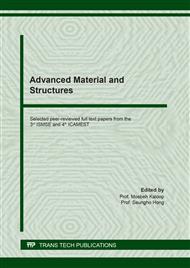[1]
R. Bekkari, L. laânab, D. Boyer, R. Mahiou y B. Jaber. Influence of the sol gel synthesis parameters on the photoluminescence properties of ZnO nanoparticles,. Materials Science in Semiconductor Processing, 71(2017), 181-187.
DOI: 10.1016/j.mssp.2017.07.027
Google Scholar
[2]
A.R. Barron, Instrumentation 16 (2010) 1–10.
Google Scholar
[3]
D. Montenegro, V. Hortelano, O. Martínez, M.C. Martínez-Tomas, V. Sallet, V. Muñoz, J. Jiménez, Mater. Res. Soc. 1538 (2013) 317–322.
DOI: 10.1557/opl.2013.548
Google Scholar
[4]
Y. Wan, Radiative and nonradiative recombination, Ppt., 2003, p.1–18.
Google Scholar
[5]
E. Fujimoto, K. Watanabe, Y. Matsumoto, H. Koinuma, M. Sumiya, Appl. Phys. Lett. 97 (2010) 2008–(2011).
Google Scholar
[6]
Z. Yang, Z. Ye, Z. Xu, B. zhao, Phys. E Low-Dimens. Syst. Nanostruct. 42 (2009).116–119.
Google Scholar
[7]
S. Mahamuni, K. Borgohain, B.S. Bendre, V.J. Leppert, S.H. Risbud, J. Appl. Phys. 85 (1999) 2861.
Google Scholar
[8]
K. Borgohain, S. Mahamuni, Semicond. Sci. Technol. 13 (1999) 1154–1157.
Google Scholar
[9]
H.S. Kang, J.S. Kang, J.W. Kim, S.Y. Lee, J. Appl. Phys. 95 (2004) 1246–1250.
Google Scholar
[10]
S. Cho, J. Ma, Y. Kim, Y. Sun, G.K.L. Wong, J.B. Ketterson, Appl. Phys. Lett. 75 (1999) 2761.
Google Scholar
[11]
T. Makino, Y. Segawa, S. Yoshida, A. Tsukazaki, A. Ohtomo, M. Kawasaki, Appl. Phys. Lett. 85 (2004) 759–761.
DOI: 10.1063/1.1776630
Google Scholar
[12]
Oscar Marin, Mónica Tirado, Nicolás Budini, Edgar Mosquera, Carlos Figueroa y David Comedi. Photoluminescence from c-axis oriented ZnO films synthesized by sol-gel with diethanolamine as chelating agent,. Materials Science in Semiconductor Processing, 56(2016), 59-65.
DOI: 10.1016/j.mssp.2016.07.007
Google Scholar
[13]
A.H. Al-Bayati, K.G. Orrman Rossiter, J.A. van den Berg, D.G. Armour, Composition and structure of the native Si oxide by high depth resolution médium energy ion scattering, Surf. Sci. 241 (1991) 91–102.
DOI: 10.1016/0039-6028(91)90214-d
Google Scholar
[14]
Y.W. Heo, D.P. Norton, S.J .Pearton, Origin of Green luminescence in ZnO thin film grown by molecular-beam epitaxy, J. Appl. Phys. (2005).
DOI: 10.1063/1.2064308
Google Scholar
[15]
P.P. Murmu, R.J. Mendelsberg, J. Kennedy, D.A. Carder, B.J. Ruck, A. Markwitz, R.J. Reeves, P. Malar, T. Osipowicz, Structural and photoluminescence properties of Gd implanted ZnO single crystals, J. Appl. Phys. 110 (2011) 033534.
DOI: 10.1063/1.3619852
Google Scholar
[16]
M. Willander, O. Nur, J.R. Sadaf, M.I. Qadir, S. Zaman, A. Zainelabdin, N. Bano, I. Hussain, Luminescence from zinc oxide nanostructures and polymers and their hybrid devices, Materials 3 (2010) 2643–2667.
DOI: 10.3390/ma3042643
Google Scholar
[17]
Liu Jin, Lv Yuanyuan, Zhang Zhiyong, Yan Junfeng, Zhao Wu, Yun Jiangniy y Zhai Chunxue. Effect of Annealing Temperature on Photoluminescence of ZnO/Graphene Nano-films Deposited by Sol-gel Method,. Rare Metal Materials and Engineering, 2017, 46(4): 0888-0892.
DOI: 10.1016/s1875-5372(17)30117-0
Google Scholar
[18]
Mahmood Khalid, Park Seung Bin, Sung Hyung Jin. Journal of Materials Chemistry [J], 2013, 1: 3138.
Google Scholar
[19]
Lee Eunsil, Kim Jong-Yong, Park Yong-Il et al. Current Applied Physics[J], 2015, 15(4): 563.
Google Scholar
[20]
Fang D, Lin K, Xue T et al. Journal of Alloy and Compound [J], 2014, 589: 346.
Google Scholar
[21]
Samavatia A, Othamana Z, Ghoshalb S K et al. Superlattices and Microstructures[J], 2015, 86: 134.
Google Scholar
[22]
Zhanga J W, Heab G, Lia T S et al. Materials Research Bulletin[J], 2015, 65: 7.
Google Scholar
[23]
Chen K, Zhu H, Yi X et al. Chinese Optics Letters[J], 2015, 10: 103101.
Google Scholar
[24]
Enigochitra A S, Perumal P, Sanjeevirajia C et al. Superlattices and Microstructures[J], 2016, 90: 313.
Google Scholar
[25]
Lin Bixia, Fu Zhuxi, Jia Yunbo. Applied physics Letters[J], 2001, 79: 943.
Google Scholar
[26]
F.Boudjouan, A.Chelouche, T.Touam, D.Djouadi, S.Khodja, M.Tazerout, Y.Ouerdane y Z.Hadjoub. Effects of stabilizer ratio on photoluminescence properties of sol-gel ZnO nano-structured thin films,. Journal of Luminescence 158 (2015) 32–37.
DOI: 10.1016/j.jlumin.2014.09.026
Google Scholar


